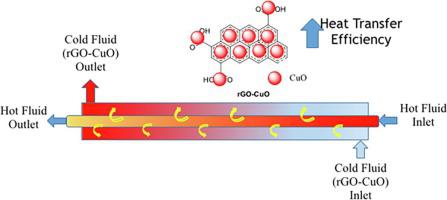FlatChem ( IF 5.9 ) Pub Date : 2021-03-24 , DOI: 10.1016/j.flatc.2021.100245 Pramanand Kumar , Babloo Yadav , Abhishek Kumar , Chandramika Bora , Arun Kumar , Subrata Das

|
In the present work, we have reported the synthesis and characterization of graphene oxide (GO) and copper oxide functionalized reduced graphene oxide (rGO-CuO) nanomaterials and studied their heat transfer properties. The synthesized materials are characterized using FTIR, XRD, UV–vis spectrophotometry, STM, EDX, SEM, and TEM analysis. Both GO and rGO-CuO nanomaterials are used as water-based NFs to study the heat transfer performance. The maximum enhancement of heat transfer rate and effectiveness of GO-water NF are found to be 18.51% and 24.58% concerning Di-water, respectively. Whereas, in the rGO-CuO-water NFs, maximum enhancement in the heat transfer rate and the effectiveness is obtained as 24.07% and 37%, compared to the Di-water, respectively. The maximum increase in Nusselt number for GO-water NF is found to be 16.48% as compared to Di-water. Whereas, for rGO-CuO-water NF is found to be 23.84% and 6.3% compared to Di-water and GO-water NFs at Reynold numbers 806.67, 1210.48, and 1617.21, respectively. These NFs may be useful in the future for heat exchanger applications.
中文翻译:

GO和rGO-CuO纳米流体在换热器中传热性能的实验研究
在目前的工作中,我们已经报道了氧化石墨烯(GO)和氧化铜功能化还原氧化石墨烯(rGO-CuO)纳米材料的合成和表征,并研究了它们的传热性能。使用FTIR,XRD,UV-可见分光光度法,STM,EDX,SEM和TEM分析对合成材料进行表征。GO和rGO-CuO纳米材料均用作水基NF,以研究传热性能。相对于二水,GO-水NF的传热率和有效性的最大提高分别为18.51%和24.58%。而在rGO-CuO-水NFs中,与Di-水相比,传热速率和效率的最大提高分别为24.07%和37%。发现GO-water NF的Nusselt数最大增加为16。与去离子水相比,为48%。相比之下,在雷诺数分别为806.67、1210.48和1617.21时,与di-water和GO-water NFs相比,rGO-CuO-水的NF分别为23.84%和6.3%。这些NF将来可能在热交换器应用中有用。







































 京公网安备 11010802027423号
京公网安备 11010802027423号